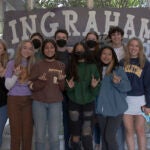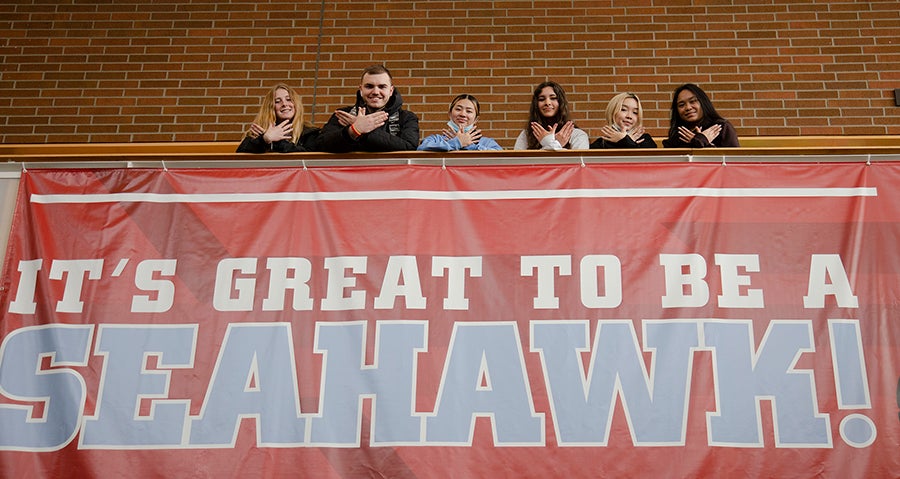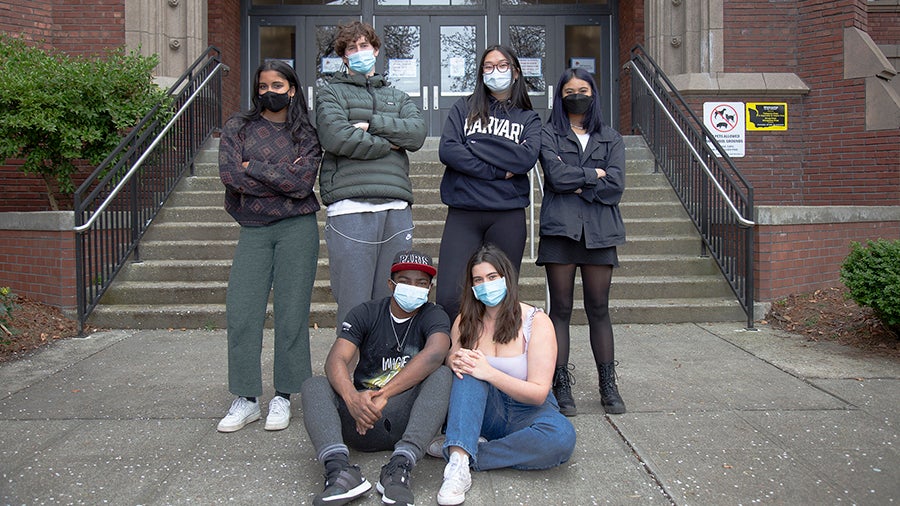Ingraham Student Government Creates New Traditions
Summary : Returning to campus after nearly two years of building closures is allowing high school student leaders to redefine school spirit.

Steeped in Tradition
Ingraham’s Student Government Used the Pandemic to Create New Traditions
At Ingraham High School, the Associated Student Body (ASB) is all business. The whiteboard in their meeting space is full of committee assignments and to-do lists. The group hunkers down to prepare a spending budget for upcoming events. ASB Advisor Traci Huffer asks the group how much they want to spend on Homecoming. Students around the room chime in, offering their opinion on what activities they think would be most engaging to their peers.
The students are efficient and collaborative as each person gets to have their say on how the money should be spent. They create a budget for everything from prom to paper and office supplies. Their process puts our own government to shame. Ingraham’s approach is simple: create an atmosphere where students not only can enjoy traditions of the past, but also promote school spirit in new ways.
After meeting with dozens of student government leaders within Seattle Public Schools, we were able to capture a glimpse of how the pandemic not only upended students’ lives but also changed the way they define school spirit. This story is the last in our series highlighting how ASB and other student leaders are working hard to rebuild school pride.

Then vs. Now
During the pandemic, students were not able to do normal high school things – no sports, no dances, no assemblies. For juniors and seniors, the only students who’d had a taste of in-person high school before the shutdown, things were not quite the same.
“I think spirit has changed a lot,” said senior Maggie Vodicka, Ingraham’s ASB secretary. “There’s been sort of a loss of spirit that we’ve seen, but we’re really trying to get that back through whatever means … So I think there is a large like difference between spirit – how it was before and how it is now.”
Unlike the upperclassmen who have some high school under their belts, freshmen and sophomores don’t know what they are missing. That unknown is a blessing and a curse.
“We haven’t seen what the traditions used to look like,” said sophomore Navaal Malik, class of 2024 vice president. “I think it’s really cool to be able to come in here and have our seniors and our juniors tell us, ‘This is what we used to do in past years, and this is an Ingram tradition.’”
Not having that sense of tradition means underclassmen get to make their own.
“I think the freshmen and sophomores are eager to bring back these Ingram traditions, but it’s not going to be the same as it was before the pandemic. That’s not a bad thing,” Malik said.
Getting Creative
Student leaders were tasked with finding ways to unite their school community. Like other schools, they started with virtual assemblies. They filmed performances, held virtual competitions, and played interactive games. The feedback from their peers was exactly what they needed to start planning in-person events. From boys’ volleyball matches to March Madness tournaments, ASB leaders have found innovative ways to unite the school.
To ASB Vice President Erin Leth, interactive activities like these have worked wonders on bringing students together. March Madness was such a hit, the school saw an increase in attendance during the 3-on-3 basketball tournament held during lunch. Players had to attend school to be eligible to participate in that day’s game.
“Having these little side spirit activities and events are really helping our students come together and create the Ingraham community,” Leth said.
Freshman Nick Babington is excited to see the increase in activities – and in turn, school spirit. Working on ASB has given him a front row seat to all the changes happening on campus.
“We didn’t see a ton of spirit related activities going into the year, but as the year has gone on … I’ve been super grateful to see how next year, we’re going to have dances and more sporting events,” he said. “It’s been cool to see how people are trying to have more spirit.”
Not All Fun and Games
Knowing that students would need more than spirit weeks and assemblies for high school to feel normal, Ingraham’s ASB developed subcommittees to lead events that would address students’ social-emotional needs as well. The group has a mental health committee and one that oversees the school’s multicultural assembly.
“We’ve seen a bad decline in mental health coming back from online school,” said ASB President MacKenzie Metcalf.
They sent out a survey to students, and according to Metcalf, it was the highest number of responses they have ever received to a student survey. The data revealed just how overwhelmed students felt after returning to in-person learning. They presented their findings to school staff in hopes of finding ways to promote mental health and well-being.
Reset
For schools across the district, the pandemic gave student leaders a chance to reimagine how they define school spirit. For underclassmen, every old tradition will still have some newness to it. Freshman Riley Magill, the vice president of the class of 2025, is looking forward to building fresh traditions for his peers.
“We haven’t known anything better than what we have right now,” he said. “It’s kind of weird thinking about how there’s so much more to high school than what we have right now.”
Chief Sealth International High School: Changing the Status Quo
As students trickle into Sarah Martin’s office to gather supplies, she doles out paper, scissors, and paint with ease. They are working on signs for their first in-person assembly in over two years. As she takes stock of the room, Martins’s eyes land on the school’s “spirit shield,” a prop that has been a long-standing tradition at Chief Sealth International High School’s pep assemblies.
“Students don’t know what it is – don’t know what it is at all,” the activities coordinator said. “It’s a good thing and a bad thing because we are missing out on these passed-down-from-student-to-student traditions, but we also are getting to start fresh.”
After meeting with dozens of student government leaders within Seattle Public Schools, we were able to capture a glimpse of how the pandemic changed the way students defined school spirit. Through this series on student government leaders, we examine how they are working hard to rebuild school pride and create new traditions.
All Are Welcome
Before COVID-19 brought the world to a grinding halt, Martin was feeling the need for a change. She noticed the traditional leadership roles of president, vice president, secretary and treasurer were not working for Chief Sealth. Studies have shown that elections do not determine the quality of a leader, but rather how well they run a campaign for office.
Martin knew there were many kids who would be great as student government leaders, but they were too intimidated by the election process to run for a position.
“It was uniquely timed because we had started to think about this pre-pandemic,” said Martin. “The traditional roles of officers and running for elections … was this barrier where a lot of students who would be good at doing this sort of stuff didn’t see themselves as an officer.”
The pandemic allowed Chief Sealth’s Associated Student Body (ASB) the opportunity to reinvent itself. In 2020, the school did away with traditional leadership roles in favor of a more inclusive model. Rather than have an election, students could opt into leadership. Interested students sign up for Martin’s Project Management class where they share ideas and come up with creative ways to boost school spirit.
A Seat at the Table
Elections were a barrier for students who did not think their voice would be heard in a standard popular vote election. Opening the door to all students reinforces Chief Sealth’s belief of providing an environment that is anti-racist and intersectional in all its practices.
Solveig Defant joined ASB at the start of second semester. The junior opted in because she felt like her ideas were not being heard.
“I didn’t really have a place to share them,” she said.
As the lone junior in the group, Defant said one of her goals is to get more of her peers involved.
“I’m hoping I can get people excited about it this year, so that next year when the senior class – who is majority of our ASB right now – we can get some juniors to join and be excited so that next year we can also have that,” she said.
Defant said the mix of grade levels has allowed her to get to know students she may not regularly have interacted with in class.
“I think it’s great because … we often get cut off by the classes … and it’s nice to hear the freshmen’s ideas too,” she said. “It’s just different because of the ages, and some people haven’t quite learned some things yet, but it just gives you a different perspective.”
Leading the Way
Joselyn Panganiban serves on ASB as a senior class representative. As a member of the only class of students who got to experience a full four years of high school, she knows just how much the underclassmen have missed.
“We’re getting a senior experience as best as we can right now, but there are certain aspects, like homecoming and pep rallies … that freshmen haven’t seen yet,” Panganiban said.
The leadership team has made it a priority to show students it is okay to show pride in their school. For Martin, dismantling the traditional leadership model has helped redefine school spirit.
“It really is just meeting students where they are at,” Martin said. “I think it is changing what it looks like to be spirited because it’s not always going to look like being a cheerleader. It’s going to be about doing stuff.”
Student Government at Lincoln High is Finding Creative Ways to Unite Their Peers
When Lincoln High School reopened in September 2019 after a nearly 40-year closure, students and staff had no way of knowing a global pandemic would close its doors again just seven months later. For the class of 2022, who were sophomores when Lincoln opened, the closure interrupted a pivotal time for the 600 students who were in a new school and still in the early stages of getting to know one another. Now with 1,400 students on the roster, building a connected community is even more critical.
After meeting with dozens of student government leaders within Seattle Public Schools, we were able to capture a glimpse of how the pandemic not only upended students’ lives but also changed the way they define school spirit. This series will highlight how Associated Student Body (ASB) and other student leaders are working extra hard to rebuild school pride.

Growing Pains
Students at Lincoln were already struggling to establish relationships. Most of them had been moved from surrounding schools like Ballard and Roosevelt to ease overcrowding. Making friends was difficult but trying to build school spirit through a computer screen was even harder.
“We already had a really hard time starting out in-person because no one knew each other,” said Nyah Curcuruto, Lincoln’s ASB president. “There was not a lot of students here; we only had two grades our very first year.”
Curcuruto said when the district went into lockdown, her team felt troubled because they did not know what to do. ASB leaders sprang into action by producing virtual assemblies over YouTube Livestream. Students were invited to submit videos, and the team recorded some of their own content to make a compilation of skits, how-to videos, and performances by the school’s dance team.
Curcuruto said their goal was to get students and staff to feel a little bit of connection and to create online that could carry forward when schools reopened for in-person learning.
“We want to leave all other grades with something to grasp on to,” she said.
Do It for the ‘Gram
The pandemic hit just as students were getting to know each other in meaningful ways. ASB had to get creative in order to keep students connected. They have a communications director on their leadership team whose sole job is to engage with students and keep them informed. Lincoln’s ASB advisor, Christina Neuschwander, has helped the leadership team push through the pandemic by allowing them to have complete ownership of their roles.
Anvita Deenadayalan is the communications director and runs Lincoln’s ASB social media accounts. She said using social media, especially Instagram, had an immediate impact.
“It was a gamechanger, the way we used social media,” she said.
Deenadayalan said crowdsourcing for students to share images – especially during COVID – drove up participation during spirit weeks. Students send in pictures of themselves wearing school gear or dressed up for one of the theme days.
“Being able to use that to bring everybody together is a great way to get participation,” Deenadayalan said.
According to Senior Class Co-President Alicia Salva, social media was also a way to share resources around mental health to let students know they were not alone during the pandemic.
We’ve Got Spirit
Senior Ryan Shigley has one job – keep spirit alive. As the ASB spirit coordinator, Shigley’s specialty is getting students to not take themselves too seriously and join in on the fun.
“It’s been cool to see … throughout a spirit week how the participation increases every day,” he said. His perception of what it means to show school spirit has shifted since his days in middle school.
“In high school, I think a lot of people have school pride,” he said. “That was something that I wanted to build.”
Lincoln now has a full slate of students, but two of the grade levels had never had an in-person school experience. Shigley says he tries to lead by example.
“The juniors and seniors and some underclassmen are willing to put themselves out there then that makes other people feel more comfortable.”
Under Construction
When it comes to building connections, Lincoln’s ASB has found a formula that works. They eliminated pitting students against each other based on grade level. Instead, they have built four “Houses” (Alki, Mohai, Madrona, and Pike). Students are grouped together based on their advisory/mentorship class – an even mix of students across all grade levels. The move ushered in another opportunity for students to bond with peers who may be in a different grade.
“It’s our way of trying not to create such a divide between classes, but to help people get to know each other,” Curcuruto said. “It’s definitely difficult for some people to transition into … you really want to resonate with your grade. We do things that are grade-oriented but doing it by House has really helped create a lot of connections between students.”
Junior Class President Chelsea Chen is thankful for the senior leaders and how they have laid a foundation for the next group of officers.
“I think the seniors this year have set such a high bar – in the best way,” Chen said. “They’ve really brought this school together, especially in terms of spirit. I think it sets the standard for all the future classes coming into it.”
